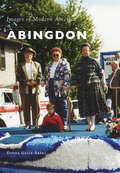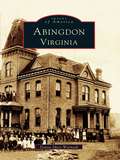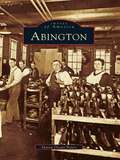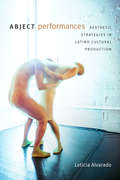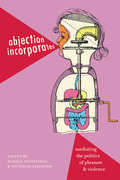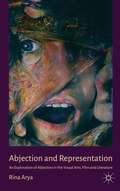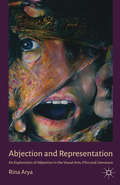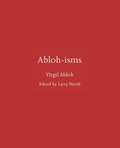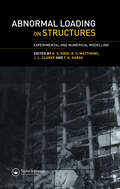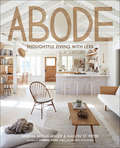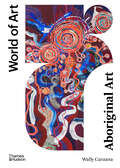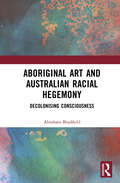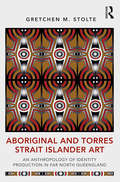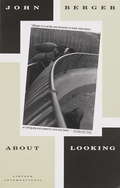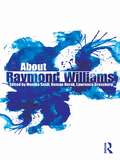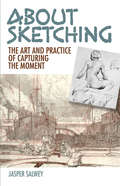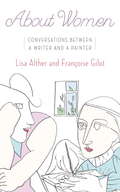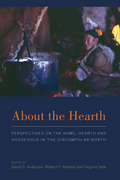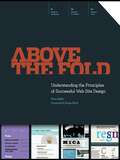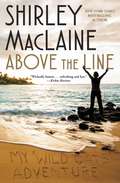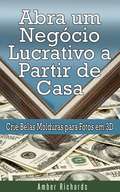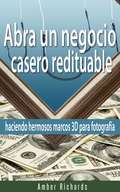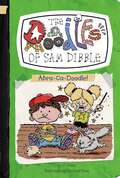- Table View
- List View
Abingdon (Images of Modern America)
by Donna Gayle AkersAbingdon, first named Wolf Hills by Daniel Boone, was one of the earliest towns and commercial centers in southwestern Virginia. Named after Martha Washington's ancestral parish in England, this unique town has weathered many economic changes and has emerged as a leading cultural and arts center for the area. Author and native Donna Gayle Akers has extensively researched and published three other books about the area's history. Using images from collectors and area historical groups, she shows Abingdon's past and the excellent preservation of its built environment.
Abingdon, Virginia
by Donna Akers WarmuthThe charming town of Abingdon is nestled in southwestern Virginia's Blue Ridge Mountains and situated along the Holston River. Originally known as Wolf Hills-a name bestowed upon the town by Daniel Boone-Abingdon was renamed in honor of Martha Washington's home in England. The town today enjoys a rich and varied palate suitable for residents and tourists, young and old alike. Images of America: Abingdon, Virginia celebrates the town's singular heritage by offering readers a rare find of almost 200 photographs, showcasing many well-known town entities, personalities, and businesses from the past century. These images portray such structures as the Stonewall Jackson Female Institute, the Abingdon Academy, the Belmont Hotel, and the Martha Washington Inn, as well as the Barter Theater, unique in its exchange of food and household goods for performances. Long-gone but rarely forgotten individuals also make appearances, allowing newcomers the chance to meet the people behind the names and longtime residents an opportunity to visit with old friends.
Abington (Images of America)
by Sharon Orcutt PetersThroughout Abington's history, its central location between Boston and Plymouth has been a vantage point that has been reflected in both work and play. It is Abington that provided the white-oak planks for the USS Constitution, and the town's Island Grove Park had national significance during the abolitionist movement. Abington was founded and built around the mills and then grew with the times to become a focal point for the thriving shoe industry. Many wealthy industrialists and capitalists have left their mark with brick and mortar. Their mansions still line the streets, and their lives shaped Abington forever.Abington presents an illustrated portrait of what it was like to live and work in the town during the nineteenth and twentieth centuries. It presents vivid images of the townsfolk, the shoe factories, and the old roads through Abington. The book includes images of John L. Sullivan, heavyweight boxing champion, and of the Buffum automobile, built on Centre Avenue. With photographs from the Abington Historical Commission, the Dyer Memorial Library, the Historical Society of Old Abington, and personal collections, Abington is sure to evoke memories of a bygone era.
Abject Performances: Aesthetic Strategies in Latino Cultural Production (Dissident Acts)
by Leticia AlvaradoIn Abject Performances Leticia Alvarado draws out the irreverent, disruptive aesthetic strategies used by Latino artists and cultural producers who shun standards of respectability that are typically used to conjure concrete minority identities. In place of works imbued with pride, redemption, or celebration, artists such as Ana Mendieta, Nao Bustamante, and the Chicano art collective known as Asco employ negative affects—shame, disgust, and unbelonging—to capture experiences that lie at the edge of the mainstream, inspirational Latino-centered social justice struggles. Drawing from a diverse expressive archive that ranges from performance art to performative testimonies of personal faith-based subjection, Alvarado illuminates modes of community formation and social critique defined by a refusal of identitarian coherence that nonetheless coalesce into Latino affiliation and possibility.
Abjection Incorporated: Mediating the Politics of Pleasure and Violence
by Nicholas Sammond Maggie HennefeldFrom the films of Larry Clark to the feminist comedy of Amy Schumer to the fall of Louis C. K., comedic, graphic, and violent moments of abjection have permeated twentieth- and twenty-first-century social and political discourse. The contributors to Abjection Incorporated move beyond simple critiques of abjection as a punitive form of social death, illustrating how it has become a contested mode of political and cultural capital—empowering for some but oppressive for others. Escaping abjection's usual confines of psychoanalysis and aesthetic modernism, core to theories of abjection by thinkers such as Kristeva and Bataille, the contributors examine a range of media, including literature, photography, film, television, talking dolls, comics, and manga. Whether analyzing how comedic abjection can help mobilize feminist politics or how expressions of abjection inflect class, race, and gender hierarchies, the contributors demonstrate the importance of competing uses of abjection to contemporary society and politics. They emphasize abjection's role in circumscribing the boundaries of the human and how the threats abjection poses to the self and other, far from simply negative, open up possibilities for radically new politics.Contributors. Meredith Bak, Eugenie Brinkema, James Leo Cahill, Michelle Cho, Maggie Hennefeld, Rob King, Thomas Lamarre, Sylvère Lotringer, Rijuta Mehta, Mark Mulroney, Nicholas Sammond, Yiman Wang, Rebecca Wanzo
Abjection and Representation
by Rina AryaAbjection and Representation is a theoretical investigation of the concept of abjection as expounded by Julia Kristeva in Powers of Horror (1982) and its application in various fields including the visual arts, film and literature. It examines the complexity of the concept and its significance as a cultural category.
Abjection and Representation: An Exploration of Abjection in the Visual Arts, Film and Literature
by R. AryaAbjection and Representation is a theoretical investigation of the concept of abjection as expounded by Julia Kristeva in Powers of Horror (1982) and its application in various fields including the visual arts, film and literature. It examines the complexity of the concept and its significance as a cultural category.
Abloh-isms (ISMs)
by Virgil AblohA collection of essential quotations from the renowned fashion designer, DJ, and stylistAbloh-isms is a collection of essential quotations from American fashion designer, DJ, and stylist Virgil Abloh, who has established himself as a major creative figure in the worlds of pop culture and art. Abloh began his career as Kanye West’s creative director before founding the luxury streetwear label Off-White and becoming artistic director for Louis Vuitton, making Abloh the first American of African descent to hold that title at a French fashion house. Defying categorization, Abloh’s work has been the subject of solo exhibitions at museums and galleries, most notably in a major retrospective at the Museum of Contemporary Art Chicago. Gathered from interviews and other sources, this selection of compelling and memorable quotations from the designer reveals his thoughts on a wide range of subjects, including creativity, passion, innovation, race, and what it means to be an artist of his generation. Lively and thought-provoking, these quotes reflect Abloh’s unique perspective as a trailblazer in his fields.Select quotations from the book:“I believe that coincidence is key, but coincidence is energies coming towards each other. You have to be moving to meet it.”“Life is collaboration. Where I think art can be sort of misguided is that it propagates this idea of itself as a solo love affair—one person, one idea, no one else involved.”“Black influence has created a new ecosystem, which can grow and support different types of life that we couldn’t before.”“Like it or not, irrelevance is death.”
Abnormal Loading on Structures: Experimental and Numerical Modelling
by J. L. Clarke F. K. Garas K. S. Vird R. S. MatthewsDesigning for hazardous and abnormal loads has become an important requirement in the design process of most major buildings and civil engineering structures, ranging from tall buildings to bridges, power plants to harbour and coastal installations. This state-of-the-art volume was compiled by the Institution of Structural Engineers' informal study
Abode: Thoughtful Living with Less
by Serena Mitnik-Miller Mason St. Peter Melissa GoldsteinCreate your space with simplicity, tranquility, and beautifully minimalist style.The yearning for a life of pared-down purity has built to a roar, and Serena Mitnik-Miller and Mason St. Peter—the husband-and-wife owners of General Store, one of California’s most talked-about shops—are at the forefront. In Abode: Thoughtful Living with Less, these tastemakers make a graceful case for living better no matter your budget or abilities, guiding you to create a space this is simple and true. Their time-tested methods create interiors that maximize openness, strip a building back to its bones, and amplify natural light, evoking unpretentious tranquility. The blueprint for their signature aesthetic is all here: the embrace of elemental materials, curation of handcrafted objects, and collection of furnishings from eras when craftsmanship was king. This selection of Mitnik-Miller and St. Peter’s greatest collaborations will take you through their breathtaking rooms, masterpieces of warm minimalism. Abode is a glimpse into the couple’s process and a guide to manifesting your own beautiful interiors.
Aboriginal Art (World of Art)
by Wally CaruanaAn updated and expanded edition of this classic survey, which has established itself as a superlative introduction to the full diversity of Aboriginal art. This concise survey showcases the incredible, diverse work of Aboriginal and Torres Strait artists. Building on traditions that stretch back at least 50,000 years, these artists have long worked in a variety of contexts from the sacred and secret realm of ceremony to more public spheres. From isolated beginnings to postcolonialism and the present, Wally Caruana explains how Aboriginal and Torres Strait Islander art has continually developed and responded to change; and considers the impact of urban living, the growth of local art centers that support the artists in these communities, and the recognition of women artists. This new edition has been expanded and updated to include and reflect on important artists who have emerged in the last decade, with a focus on the burgeoning of activity in the Southern Desert region, Queensland, and the Torres Strait Islands—all testament to Aboriginal art’s continued dynamism and vitality.
Aboriginal Art and Australian Racial Hegemony: Decolonising Consciousness
by Abraham BradfieldThis book explores the complexities of Indigenous and non-Indigenous relations in contemporary Australia. It unpacks the continuation of a pervasive colonial consciousness within settler-colonial settings, but also provokes readers to confront their own habits of thought and action. Through presenting a reflexive narrative that draws on the author’s encounters with Indigenous artists and their artwork, knowledge, stories, and lived experiences, this provocative and insightful work encourages readers to consider what decolonising means to them. It presents a compelling and relevant argument that calls for a reorientation of dominant discourses fixed within Eurocentric frameworks, whilst also addressing the deep complexities and challenges of living within intercultural settler-colonial settings where different views and perspectives clash and complement one another.
Aboriginal and Torres Strait Islander Art: An Anthropology of Identity Production in Far North Queensland (Criminal Practice Ser.)
by Gretchen M. StolteAboriginal and Torres Strait Islander Art explores the effects of Queensland government policies on urban First Nation artists. While such art has often been misinterpreted as derivative lesser copies of ‘true’ Indigenous works, this book unveils new histories and understandings about the mixed legacy left for Queensland Indigenous artists. Gretchen Stolte uses rich ethnographic detail to illuminate how both Aboriginal and Torres Strait Islander artists understand and express their heritage. She specifically focuses on artwork at the Aboriginal and Torres Strait Islander art studio in the Tropical North Queensland College of Technical and Further Education (TNQT TAFE), Cairns. Stolte's ethnography further develops methodologies in art history and anthropology by identifying additional methods for understanding how art is produced and meaning is created.
About Looking (Vintage International)
by John BergerAs a novelist, art critic, and cultural historian, John Berger is a writer of dazzling eloquence and arresting insight whose work amounts to a subtle, powerful critique of the canons of our civilization. In About Looking he explores our role as observers to reveal new layers of meaning in what we see. How do the animals we look at in zoos remind us of a relationship between man and beast all but lost in the twentieth century? What is it about looking at war photographs that doubles their already potent violence? How do the nudes of Rodin betray the threats to his authority and potency posed by clay and flesh? And how does solitude inform the art of Giacometti? In asking these and other questions, Berger quietly -- but fundamentally -- alters the vision of anyone who reads his work.From the Trade Paperback edition.
About Raymond Williams
by Lawrence Grossberg Monika Seidl Roman HorakAbout Raymond Williams represents the overdue critical acclaim of Williams’ lasting influence and unbroken repercussions in critical thought. His writings have effectively shaped the ways in which people understand the complexity of the notion of 'culture' and many of the ways it has been taken up in scholarly practice.
About Sketching: The Art and Practice of Capturing the Moment
by Jasper Salwey Leonard SquirrellWritten as a sketching artist's companion, this guide by a noted author of art instruction manuals attests to the value of sketching as a distinct art form rather than merely a vehicle to achieve more polished works. Artist and author Jasper Salwey details advantages of many drawing media, from pencil to watercolor, and their application to depictions of interior studies, figures, landscapes, seascapes, and architecture.Suitable for artists and students of moderate to advanced skills, the book makes a case for why the artist needs to sketch and the importance of sketching to the history of art. Salwey's advice and insights are illustrated by relevant examples that range from works by the Old Masters to those of his great contemporaries, including Frank Brangwyn, Dame Laura Knight, and John Singer Sargent.
About Women
by Lisa Alther Francoise GilotA provocative and wide-ranging conversation between two distinctive women--one American and one French--on the dilemmas, rewards, and demands of womanhood.Lisa Alther and Françoise Gilot have been friends for more than twenty-five years. Although from different backgrounds (Gilot from cosmopolitan Paris, Alther from small-town Tennessee) and different generations, they found they have a great deal in common as women who managed to support themselves with careers in the arts while simultaneously balancing the obligations of work and parenthood. About Women is their extended conversation in which they talk about everything important to them: their childhoods, the impact of war on their lives and their work, and their views on love, style, self-invention, feminism, and child rearing. They also discuss the creative impulse and the importance of art as they ponder what it means to be a woman.From the Hardcover edition.
About the Hearth
by David G. Anderson Virginie Vate Robert P. WishartDue to changing climates and demographics, questions of policy in the circumpolar north have focused attention on the very structures that people call home. Dwellings lie at the heart of many forms of negotiation. Based on years of in-depth research, this book presents and analyzes how the people of the circumpolar regions conceive, build, memorialize, and live in their dwellings. This book seeks to set a new standard for interdisciplinary work within the humanities and social sciences and includes anthropological work on vernacular architecture, environmental anthropology, household archaeology and demographics.
Above Victoria and Vancouver Island
by Russ Heinl Gillian BirchABOVE VICTORIA AND VANCOUVER ISLAND is a stunning collection of 105 aerial photographs of Vancouver Island, BC taken by renowned photographer, Russ Heinl. This high-quality ebook offers a series of breathtaking images, capturing aerial views of Vancouver Island's spectacular landscapes in precise detail. Heinl's diverse subjects range from the ivy-covered Empress Hotel in Victoria to surfers riding world-class surf at Tofino and Long Beach. Those who enjoy British Columbia's great outdoors will appreciate these awe-inspiring aerial views of Vancouver Island's magnificent snow-capped peaks of Mount Washington and Strathcona Provincial Park. Nature lovers will pore over the images of Grey Whales, right down to the barnacles on their tail fins as the whales complete their annual migration along the coast of Vancouver Island, celebrated by thousands attending the Pacific Rim Whale Festival. See "The Snowbirds" flying in formation over Vancouver Island, seals basking on rocky offshore islets and a host of magnificent coastal views captured in this stunning ebook of aerial photographs. Chapters feature Tofino, Long Beach and the Pacific Rim National Park, Port Hardy and Cape Scott, the scenic waterfront at Nanaimo, Victoria, the elegant capital city of British Columbia and its suburbs of Sidney and Sooke. Using the latest gyro-stabilized Nikon camera systems these stunning views of the earth from the air show Vancouver Island at its very best. From the open door of the helicopter, aerial photographer Russ Heinl has captured the charismatic splendour and remote natural beauty of Vancouver Island, its cities, mountains, beaches and wildlife. Enjoy these aerial views time and time again with this beautiful photography ebook of Victoria and Vancouver Island.
Above the Fold, Revised Edition
by Brian D MillerAbove the Fold is a book about the fundamentals of clear graphic communication within the context of Web design. The book has three sections, which follow the cycle of a typical Web project:PLAN Section I focuses on the predesign phase of a Web project. From project planning and brief writing to information architecture and responsive grid creation.DESIGN The second section of Above the Fold explores the enduring principles of design and the nuances that are specific to the field of Web design.OPTIMIZE Finally, we close the loop and discover ways to enable your client to maximize the investment they've made in their Web site with marketing and analytics.
Above the Fold: Understanding the Principles of Successful Web Site Design
by Brian MillerThis is a different kind of web design book. Above the Fold is not about timely design or technology trends; instead, this book is about the timeless fundamentals of effective communication within the context of web design. It is intended to help you, the reader, understand the considerations that web designers make when developing successful websites.Above the Fold is divided into three sections:Design & TypographyPlanning & UsabilityBusiness Value Each section represents a phase in the continuous cycle of web design. It's the balance among design, usability, and return on investment that makes a website truly great.Topics covered in Above the Fold include:What makes web design uniqueThe history of web designAnatomy of a web pageWhite space and grid use in web designThe elements of web design: color, texture, imagery, scale, depth, animation, and variabilityWeb typography, including web-safe type, images of type, and font replacement and embeddingWeb project planningInformation architecture, including site maps, wireframes, and user flow diagramsThe elements of usability: navigation, breadcrumbs, links, search, submission forms, and error messagingSearch engine optimizationOnline marketing, including banner ads, viral and social marketing, on-site marketing, and email marketingWeb statistics and analysis
Above the Line: My Wild Oats Adventure
by Shirley MacLaineA funny, fierce, imaginative memoir chronicling New York Times bestselling author and Academy Award winner Shirley MacLaine’s remarkable experiences filming Wild Oats in the Canary Islands and the extraordinary memories her time there brought forth of a past life on the lost continent of Atlantis.Her agent advised her not to get on the plane. The male leads weren’t even cast. The financing was shaky at best. The script had been rewritten countless times. And yet something about Wild Oats lured Shirley MacLaine to the film’s location shoot in the far-off Canary Islands—and straight to the center of one of the most thrilling and paradigm-shifting adventures of her life. The making of the film reads like a screwball comedy, as the cast and crew face unpredictable daily obstacles with ingenuity, grit, and personal sacrifice. Yet the chaos leads Shirley to a revelatory new understanding of the demise of one of history’s most elusive yet endlessly intriguing places. Scholars have long theorized that Spain’s Canary Islands are the remnants of the mighty lost continent of Atlantis. As the movie set descends into pandemonium, Shirley finds fascinating corollaries between the island’s cataclysmic fate and our own dangerous trajectory. Can we learn the lessons the citizens of Atlantis failed to comprehend? The answer is borne out of recovered memories from Shirley’s past life on Atlantis and through a series of meditations that reveal the necessity of unfettered imagination when looking for bold new truths, rendering this evocative, irreverent, and honest memoir essential reading for anyone seeking a broader understanding of what it means to be human—both where we came from and where we are going.
Abra um Negócio Lucrativo a Partir de Casa
by Amber Richards Isabel Maria P. BarbosaClassificação de 5 estrelas para uma ideia criativa de criação de um negócio a partir de casa Neste E-book irá aprender a iniciar um negócio a partir de casa criando bonitas molduras para fotos em 3D. As molduras em 3D são molduras para fotos criadas de forma única e contêm vários tipos de enfeites aplicados com o objetivo de criar uma obra de arte que expõe fotos com singular beleza. É um olhar sobre as opções envolvidas, quer seja criar as molduras como um hobby, iniciar negócio a partir de casa ou abrir uma loja física comum. O livro analisa os aspetos de criação das suas molduras enfeitadas de forma original, como desenhar e conceber os seus projetos e até fazer o marketing do seu produto final. Contudo, o principal foco é o aspeto criativo deste tipo de negócio. Existem muitas razões pelas quais as pessoas procuram ter um negócio a partir de casa e o livro sublinha alguns dos motivos e dos benefícios. Está fora do âmbito de aplicação do livro analisar em demasia os impostos, se devemos ou não fazer incorporações, obter capital de arranque, aconselhamento jurídico ou consultoria contabilística, fazer pesquisa de mercado e criar um plano de negócio, pois estes tópicos podem ser extensos e implicam a leitura de livros inteiros. Existem, contudo, recursos listados para ajudar os leitores a escolherem a direção certa para juntar mais dados sobre os tópicos mencionados acima, antes de prosseguirem. As diligências preliminares são necessárias se deseja iniciar algum negócio. Se procura um possível negócio a partir de casa, este é uma boa leitura para ajudá-lo a decidir se deve ou não seguir este caminho.
Abra un negocio casero redituable haciendo hermosos marcos 3D para fotografía
by Amber Richards Carlos M. OchoaEste libro indaga la posibilidad de abrir un negocio casero de hacer bellos marcos 3D para fotografías. Los marcos 3D son de diseño único, marcos para fotos con varias formas de adornos utilizados para crear una obra de arte, que muestra a las fotografías de manera hermosa. Es un vistazo a las opciones disponibles, ya sea a nivel de un pasatiempo, un negocio casero, una tienda regular, o un almacén. Profundiza en el aspecto de que usted haga sus propios marcos para fotografía con adornos, diseñe sus proyectos, e incluso comercialice su producto terminado. El enfoque principal esta sobre el aspecto creativo de este tipo de negocios. Hay muchas razones por las cuáles la gente busca tener un negocio casero, y se centra en algunas de las razones y beneficios. Queda fuera del rango de este libro indagar acerca de los impuestos, incorporarse o no, obtener el capital inicial, obtener asesoría legal o contable, la investigación de mercado, o crear un plan de negocios, pues cada uno de estos asuntos puede llegar a ser muy extenso y merecería un libro por sí mismo. Sin embargo, hay recursos enumerados para orientar a los lectores en la dirección correcta para que pueda reunir más información de los temas mencionados, antes de que proceda. Se requiere de la preparación adecuada cuando se considera abrir un negocio. Si usted está buscando un posible negocio casero, esta es una buena lectura para considerar esta opción.
Abra-Ca-Doodle! #4 (The Doodles of Sam Dibble #4)
by J. PressSam's school is hosting a talent show to raise money for the Environmental Center. But Sam doesn't have a talent to perform! Or so he thinks. He tries juggling, but just can't get the hang of it. Plus, his arch-nemesis, Wax, decides to juggle in the talent show as well--and Wax is good. But in a moment of inspiration, Sam learns that sometimes you don't have to look very far to find out what you're really good at!
